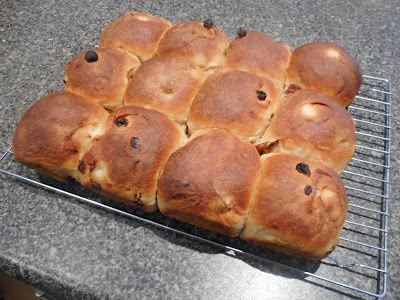Just a quick correction on oven temps, which I got wrong on the workshop day. It's 210 degrees Celcius (fan-forced) and 220 convection oven. Which is why the loaves I took out, were a little underdone. My apologies for that slight oversight.
Cooked sourdough fruit buns
We did eat some fruit buns at the workshop though, which is worth noting the recipe variances to make a basic white loaf, into these fruit buns. This will yield 12 buns, if baked in a Lamington tin (30 x 24cm).
Make the sponge, by splitting the starter and feeding it 1 cup of bakers flour to 1 cup of room temperature water. Stir well, and then add to your sponge bowl only:
1 1/2 cups sultanas
{I use regular ALDI sultanas}
Allow the sponge to sit 2-4 hours, or until its thick and filled with bubbles. You can let it go up to 8 hours if need be. When ready to make the dough, add to the sponge:
1 teaspoon cinnamon
1 teaspoon mixed spice
few drops of orange essence or a crushed to powder, vitamin C tablet (optional)
1 teaspoon salt
2 tablespoon full cream milk powder
2 tablespoon full cream milk powder
1/4 cup sugar
2 tablespoons olive oil
2 tablespoons olive oil
2-3 cups bakers flour
Once you've incorporated enough flour to make it tacky, knead for up to 10 minutes, or until the dough forms a tight (but spongy) ball. Spray the bowl you intend for the dough to rise in, with oil, then cover with a wet tea towel, cling film or plastic lid, over your bowl. This prevents a skin from forming.
First rise
Let rise for approximately 4-8 hours. Or until it has doubled in size. The above photo shows a finished dough, ready to be moulded into balls.
To get 12 rolls, first start by removing the dough from the bowl and kneading it for about 30 seconds on the bench. Roll into a ball again, then with a large chef's knife, make a cut, horizontally and vertically.
Cut into quarters
This initial cross, gives the guide to cut each quarter, into thirds. Think of a clock face, and cutting twice, at each number between, 3, 6, 9 and 12 o'clock positions.
12 pieces
It doesn't matter if some pieces are larger than others, because you can always cut a little off one, and add it to another. Keep using that chef's knife for getting the balls equal.
Then you want to roll each segment into a ball.
Rolling segments
I find it easy to cup my hand around the dough (fingertips facing down on the bench) and moving in a circular motion. The top of the dough, barely touches the palm of my hand. If you press down hard, with the palm of your hand, you'll flatten the roll.
Or do it how best you feel comfortable, achieving a ball shape.
Ready for second rise
Next, spray your Lamington tin with oil and space balls, evenly on the tray. The sides of the Lamington tin, will help the balls, meld together as they rise.
Remember to use your oven as a prover, set to approximately 50 degrees Celcius (fan-forced) with a bowl of hot water, in the bottom. Preheat oven for 5 minutes, before adding rolls. Then you can switch the oven off, ten minutes, after putting the rolls in. The residual heat and water should make it perfect for rising.
Ready to bake
Let the buns, rise in the make-shift prover for approximately 1 hour. They should double up nicely. When ready to cook remove from the oven and place on a bench, out of the way. Then preheat oven to 180-200 degrees Celsius (fan forced) 200-220 for a standard oven.
Cook for approximately 25-30 minutes. These are delicious and make great snacks for lunch boxes. You can even freeze them individually and wrap in cling film, to keep fresh, if you're not going to be able to eat them, in a few days.
As I learned at the workshop however, each oven differs and you really need to learn what temp works best, cooking in your oven. I know my oven perfectly, but other ovens will vary. After a few goes you'll learn what temperature works best for what time frame.
As I learned at the workshop however, each oven differs and you really need to learn what temp works best, cooking in your oven. I know my oven perfectly, but other ovens will vary. After a few goes you'll learn what temperature works best for what time frame.








Thanks so much for these instructions, Chris. I am going to print out all your sourdough posts when I get a chance.
ReplyDeleteYou're welcome Chel. Do enjoy your sourdough fruit buns. They're such a light treat to take to a morning tea, or to stow away individually, in your handbag, if you're going out for the day. :)
ReplyDeleteThank you for the instructions for the lovely buns, I will give them a try after I make the pull apart. Everything we tasted at the workshop was delicious and so light and tasty.
ReplyDeleteThank you for all the inspiration.
You're welcome Margaret. :) I hear there is much bread making happening lately, and I'm excited for everyone who is giving it a try.
Delete